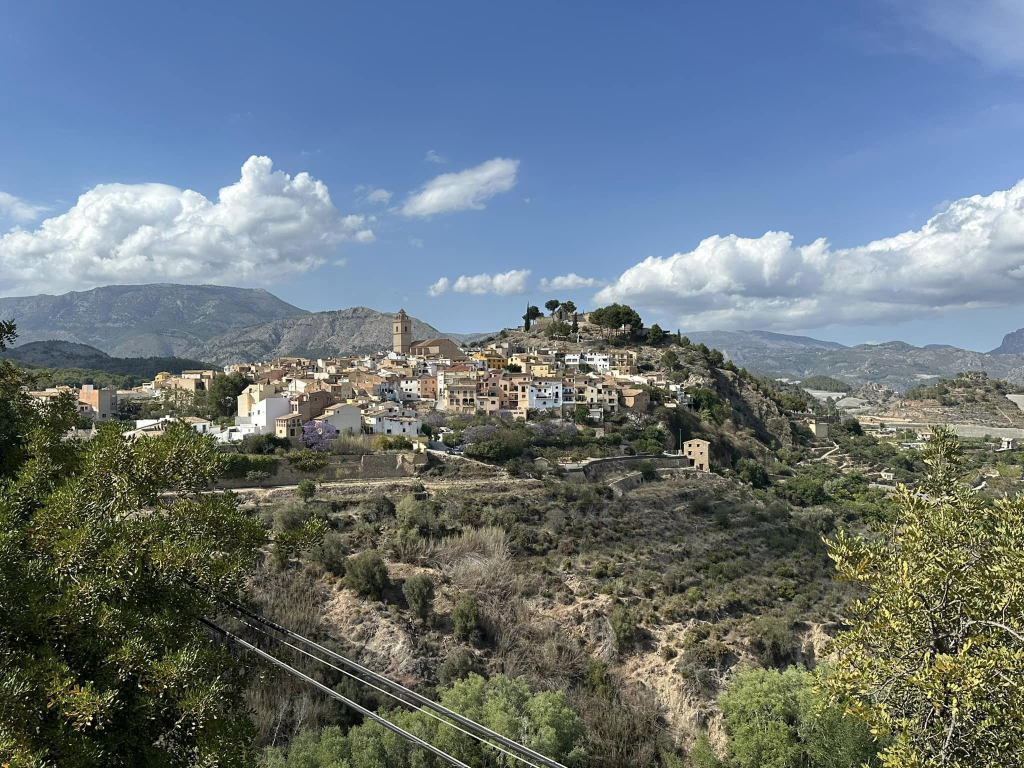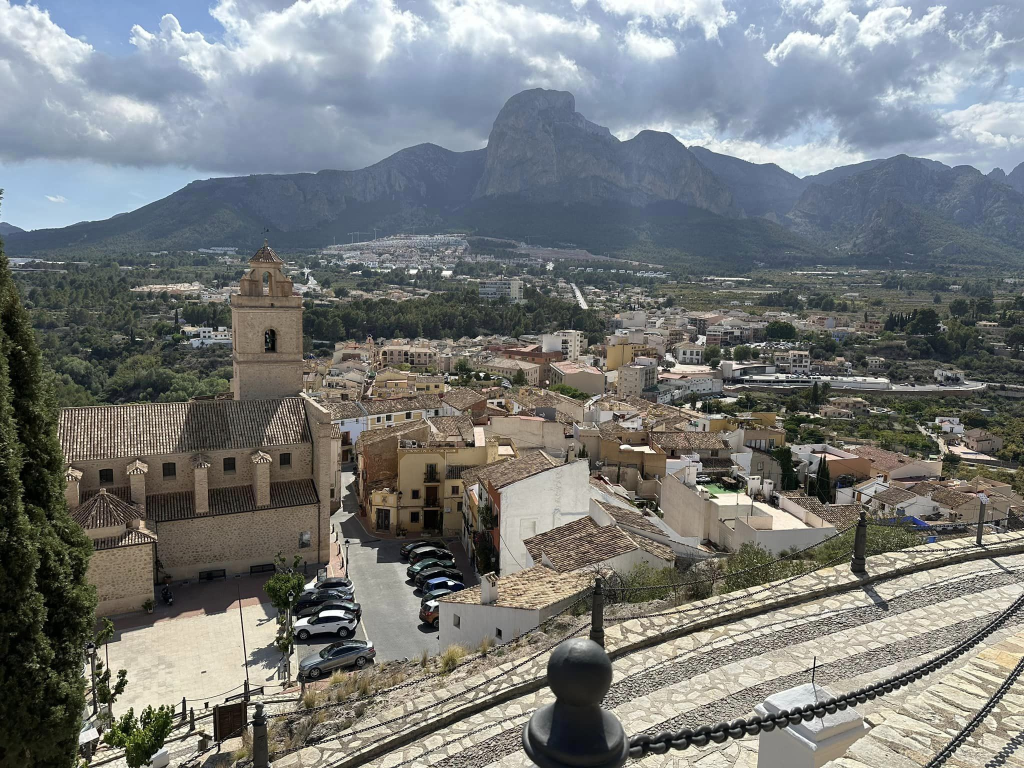Visita la antigua Baronía de Polop

Hoy ecidimos explorar el interior, pero igualmente histórico pueblo de Polop de la Marina (a menudo llamado simplemente Polop), aproximadamente a 10-12 kilómetros de Alfas del Pi.
Esta ciudad relativamente pequeña fue originalmente un antiguo señorío hereditario español en el reino de Valencia y jugó un papel crucial en varias batallas, especialmente durante la invasión árabe, que duró varios siglos. El Cid, el legendario líder militar y político, vivió aquí brevemente entre 1089 y 1090, antes de liberar y gobernar Valencia.
Comenzamos nuestra visita subiendo una colina empinada para visitar las ruinas del histórico castillo medieval y nos detuvimos para disfrutar de una bebida en el bar que está convenientemente ubicado a mitad de la colina con unas vistas magníficas de este bonito y pequeño pueblo y el campo circundante. La montaña Monte Ponoig ofrece un precioso telón de fondo y, con 1.181 metros, es muy popular entre los escaladores.
Este castillo en la cima de una colina data del siglo XII, cuando su función principal era la defensa de la ciudad. Incluso después de la victoria católica, a la población, principalmente morisca, se le permitió seguir viviendo en Polop, aunque las rebeliones fueron bastante regulares y, en general, fueron reprimidas con mano dura.

Hace poco más de quinientos años, en 1520, después de una rebelión de los residentes moros restantes, el juego terminó. Los moros se refugiaron en el castillo, pero fueron engañados y masacrados. En 1609, todos los moros fueron expulsados de España por decreto y dos tercios de la población de Polop se marcharon.
Los terrenos del castillo de Polop fueron utilizados posteriormente como cementerio y alcanza fama literaria en el libro «Años y Leguas» del escritor español Gabriel Miró, quien fue un visitante habitual en los años 20. Incluso hay un museo dedicado a este famoso escritor. (al lado de la Plaza de los Chorros.)

Mientras estábamos en Polop, paseamos por las calles antiguas y visitamos la Plaza de los Chorros, una plaza con un total de 221 fuentes de agua, que llevan el nombre de los municipios locales. Muchos lugareños vienen aquí para llenar sus botellas de agua.

No se puede subestimar la importancia del agua aquí. Polop se estableció en el nacimiento de cuatro ríos, lo que hizo que la tierra local fuera muy fértil. En 1666, la baronesa Beatriz de Fajardo decidió construir una serie de canales de agua, conocidos como Riego Mayor de Alfaz. Muchos de estos canales aún están intactos y permitieron desarrollar lugares como Alfas del Pi y Benidorm. Gracias al suministro de abundante agua, Alfas pudo crecer y se independizó de Polop en 1836.
Hay mucho que ver y explorar en su próxima visita a Albir o Altea. Para más información, eche un vistazo a VisitAlbir.com

Como llegar aquí; Las opciones de transporte público desde Albir y Altea son limitadas, sin necesidad de entrar en Benidorm para coger un autobús. Si conduces hasta aquí, puedes combinarlo con una visita al cercano pueblo de La Nucía o tomarte un tiempo para visitar las fabulosas cascadas, a sólo diez minutos en coche.
Fuente: We Love Albir & Altea
Las Fuentes de Algar
Visit the ancient baronry of Polop
Following last week’s visit to the historic coastal town of Villajoyosa, we decided to explore the inland, but equally historic village of Polop de la Marina, (often just called Polop), approximately 10-12 kilometres from Alfas del Pi.
This relatively small town was originally an ancient Spanish hereditary lordship in the kingdom of Valencia and played a crucial part in various battles, especially during the Moorish invasion, which lasted for several centuries. El Cid, the legendary military leader and politician, lived here briefly in 1089-1090, before going on to liberate and rule Valencia.
We started our visit climbing a steep hill to visit the historic medieval castle ruins, and stopped off to enjoy a drink in the bar which is conveniently located half way up the hill with some magnificent views to this pretty little village and the surrounding countryside. The mountain Monte Ponoig provides a lovely backdrop and at 1,181 metres, it is very popular with climbers.
This hilltop castle dates back to the 1200s, when its primary role was in the defence of the town. Even after the Catholic victory, the mainly Moorish population were allowed to continue living in Polop, although rebellions were quite regular and were generally suppressed with a heavy hand.
Just over five hundred years ago, in 1520, after a rebellion by the remaining Moorish residents, the game was up. The Moors took shelter in the castle, but they were tricked and massacred. By 1609, all the Moors were expelled from Spain by decree and two thirds of the population of Polop left.
The grounds of Polop castle were later used as a cemetery and it achieves literary fame in the Spanish writer Gabriel Miro’s book «Años y Leguas», as he was a regular visitor in the 1920s. There is even a museum dedicated to this famous writer. (next to the Plaza de los Chorros.)
Whilst in Polop, we wandered around the old streets and visited the Plaza de los Chorros, a square with a total of 221 water fonts, named after local municipalities. Many locals come here to fill up their water bottles.
The importance of water here can not be understated. Polop was established at the source of four rivers, which made the local land very fertile. In 1666, Baroness Beatriz de Fajardo decided to construct a series of water canals, known as Riego Mayor de Alfaz. Many of these canals are still intact and it enabled places like Alfas del Pi and Benidorm to be developed. As a result of the supply of abundant water, Alfas was able to grow and it gained independence from Polop in 1836.
There is lots to see and explore on your next visit to Albir or Altea, For more information, take a look at VisitAlbir.com
How to get here; Public transport options from Albir and Altea are limited, without going in to Benidorm to get a bus. If you drive here, you could combine it with a visit to the nearby town of La Nucia or take time to visit the fabulous waterfalls, just a ten minute drive away. (https://visitalbir.com/font-dalgar/)

Debe estar conectado para enviar un comentario.